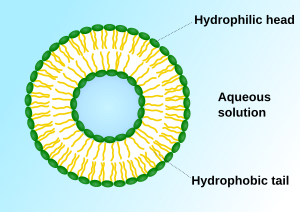Vesicle facts for kids
A vesicle is like a tiny, bubble-shaped package inside a cell. Think of it as a small sac, surrounded by a special skin called a membrane. These little bubbles are super important because they help store, move, and even release different substances within a cell. They form naturally thanks to the way cell membranes are built.
Contents
What Are Vesicles and Why Are They Important?
Vesicles are small, enclosed sacs found inside cells. They are made of the same material as the cell's outer membrane. These tiny bubbles act like delivery trucks or storage units for the cell. They carry important materials from one part of the cell to another, or even bring things into the cell from the outside.
How Do Vesicles Form?
Vesicles form when a small part of a cell's membrane pinches off. This can happen in a few ways:
- Budding: Sometimes, a part of a larger organelle (like the Golgi apparatus) or the cell's outer membrane will bulge out and then pinch off to form a new vesicle.
- Endocytosis: This is a special process where the cell's outer membrane wraps around something from outside the cell. It then pulls that substance inside, forming a vesicle around it. It's like the cell "eating" something by wrapping it up.
- Exocytosis: This is the opposite of endocytosis. A vesicle carrying something important moves to the edge of the cell. It then merges with the cell's outer membrane and releases its contents outside the cell. This is how cells get rid of waste or send out messages.
What Do Vesicles Do Inside Cells?
Vesicles have many important jobs that help cells stay healthy and work properly:
- Transporting Materials: They move proteins, fats, and other molecules to different parts of the cell. Imagine them as tiny mail carriers.
- Storing Substances: Some vesicles store enzymes, hormones, or waste products until they are needed or can be removed.
- Digesting Waste: Special vesicles called lysosomes contain powerful chemicals that break down waste materials and old cell parts.
- Sending Messages: Vesicles can carry chemical signals from one cell to another, helping cells communicate.
Different Kinds of Vesicles
There are many types of vesicles, each with a specific job:
- Transport Vesicles: These move substances between different organelles, like from the endoplasmic reticulum to the Golgi apparatus.
- Secretory Vesicles: These carry substances that need to be released outside the cell, such as hormones or neurotransmitters.
- Lysosomes: These are like the cell's recycling centers. They break down waste and old cell parts.
- Vacuoles: In plant and fungal cells, vacuoles are very large vesicles that store water, nutrients, and waste. They also help maintain cell shape.
Vesicles are tiny but mighty! They are essential for almost every process that happens inside a cell, keeping everything organized and working smoothly.


